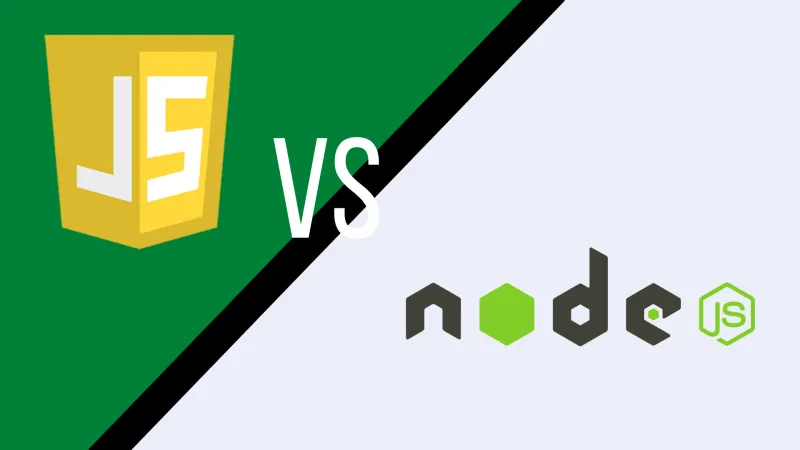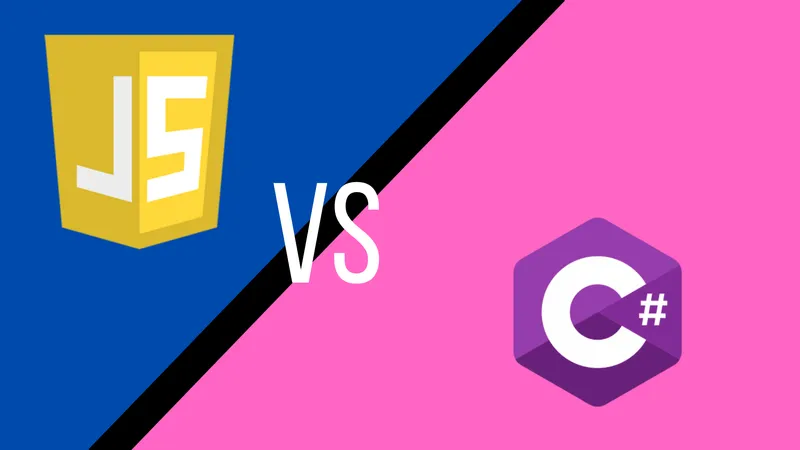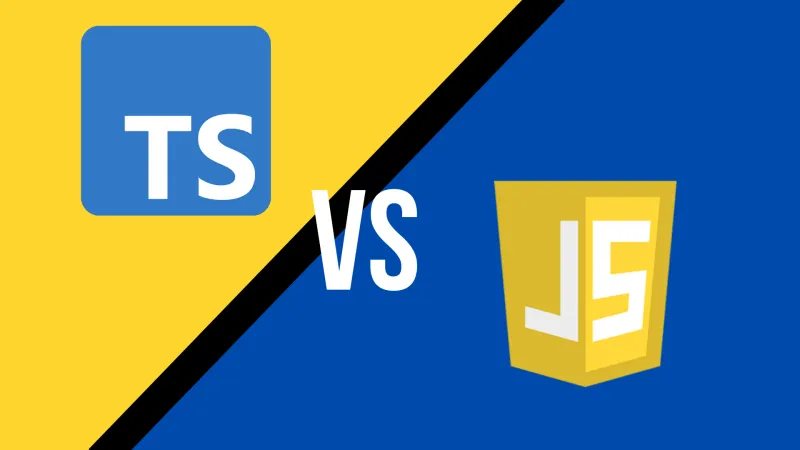So you’re a fan of web development? Great! You’re probably already familiar with JavaScript (if not, check out our JavaScript course here) and may have heard of Node.js as well. But which one is better, and how are they different? When should you pick Node.js vs JavaScript?
To be clear, there isn’t really a decision to be made when choosing JavaScript or Node.js, you’ll likely use both if you’re running JavaScript outside of a browser. JavaScript is a programming language, and Node.js is a JavaScript interpreter.
During one of my first professional coding interviews, the main piece of feedback I was given was to learn JavaScript. It’s a versatile and incredibly easy-to-learn language. You can get a working algorithm or website up and running in no time. Since most of the websites on the Internet are implemented using JavaScript, there is no shortage of tutorials to guide you.
It’s a great language for beginners and a must-know for anyone interested in UI or front-end development. Node.js can be more elusive to wrap your head around. And guess what: it’s not even a programming language!
So if JavaScript is a programming language and Node.js is not, why even compare them? In truth, Node.js is an environment in which JavaScript code can be run. The more pointed question is then, when should Node.js be used in conjunction with JavaScript, and when is JavaScript best used strictly in the browser? Let me equip you with the knowledge to make this judgment call yourself, as the answer depends entirely on what you want to use them for.
This article includes an overview of JavaScript vs Node.js, describes how they are different, analyzes the advantages and disadvantages of each, and discusses which is best to become comfortable with when it comes to your career goals.
Overview of JavaScript and Node.js 🔗
JavaScript versus Node.js boils down to the matter of a flexible and simple frontend programming language versus the framework that allows it to extend into the backend realm.
JavaScript 🔗
JavaScript is omnipresent on today’s internet: 95% of the Internet’s websites use it. There likely isn’t a professional website that doesn’t use JavaScript. It’s essential for an elevated user experience when it comes to speed, reliability, and aesthetics of a website.
JavaScript is a scripting language upon which most websites are based. It is often used in combination with HTML and CSS to render web pages, as JavaScript can be used to dynamically update HTML elements. It allows you to automatically refresh the page to update data, display information using cool visuals, and create interactive elements.
JavaScript is an interpreted language, meaning it is handed over to the browser or Node.js in its original JavaScript form instead of being compiled into machine code, like Golang, C, and C++ are. Modern browsers often use just-in-time (JIT) compiling with JavaScript to run it more efficiently. JIT compilation compiles the code as it is run. You can read more about it in the context of Node.js and JavaScript here. However, since this is done at runtime, JavaScript is still considered an interpreted language.
Remember, JavaScript alone should be thought of as a purely frontend (or client-side language) when it is used without Node.js. Client-side JavaScript code is downloaded, then run and displayed by the end-user’s browser.
Node.js 🔗
Node.js is an environment that can run JavaScript code without a browser. It is built on Chrome’s V8 JavaScript engine. The Node.js environment can be run on OS X, Windows, and Linux. It also includes a multitude of JavaScript libraries, which allow developers to leverage open source components and tools to get their applications built faster.
Unlike other server-side platforms, like the Apache HTTP server, Node.js is a single-thread server, meaning it just has one thread of execution versus multiple (read more about single vs multi-threaded processing here). It is also, however, completely asynchronous. All of Node.js’s associated libraries are also asynchronous. It’s based on an event strategy. A call to an API is made, but execution continues instead of pausing the thread until the response comes back. Instead, a notification event is issued when the API’s response is received, allowing other code to be executed in the meantime.
Just because the Node.js processing is single-threaded does not mean you can’t take advantage of your environment’s multiple processing cores. Child processes can be spawned using Node.js’s child_process.fork() API. Node.js is an open-source platform that is used by a lot of big tech companies, meaning that it is actively developed, a lot of documentation exists, and most questions are answered on popular software development forums.
Complementary to JavaScript on its own though, Node.js is on the server-side. Rather than comparing Node.js vs JavaScript, you should understand that Node.js enables JavaScript code to be run on the server. The results are then downloaded and displayed in the browser.
Advantages and Disadvantages of Node.js vs JavaScript 🔗
Both JavaScript on its own and JavaScript used with Node.js have their strengths. The great news is that both are heavily represented in the open-source community (JavaScript and Node.js) as well as professional usage. Almost all major companies like LinkedIn, Netflix, Medium, Facebook, Google, and Microsoft use both Node.js and JavaScript. All modern tech companies (or even just the IT departments of non-tech companies) will entail roles that require the use of one if not both.
JavaScript Advantages 🔗
JavaScript was originally embedded in a website’s HTML and therefore only used on the client-side.
Even today, if your goal is to produce a very simple and fast webpage, sticking to JavaScript is your best bet, as it is more responsive to the end-user and is less expensive on the server-side, as it has more in-browser execution.
That means fewer requests will be made to the server, as the entirety of your JavaScript code for the site gets passed to the page at the start to be executed by the browser. If you don’t need a bulky backend, or you’re using a different programming language like Go for backend work, JavaScript is better used on its own.
Node.js Advantages 🔗
Having two separate languages for the client-side and server-side can be frustrating, as there’s added complexity and expertise needed to develop and maintain the system.
Developers in the tech industry were fed up with the limitations of the Apache HTTP server, so Ryan Dahl created Node.js to simplify the web application development experience. Developers today use Node.js to run JavaScript on the server-side to output dynamic content before the page is rendered in the browser. Hurrah! Web development is made simple.
If your application falls into the category of data-intensive real-time applications (DIRTs) or requires a lot of I/O interactions, Node.js will perform significantly better due to its asynchronous and Event-driven nature. I/O, or input/output, refers to when your program interacts with the outside world. This could be the input from a user’s keyboard or saving some data to a database.
These I/O interactions are typically handled by sending a request and waiting for a response. With Node.js’s events, the request to save data can be sent off, the execution of the main process can continue without waiting on the response. When the response returns, it will be handled. This is significant because your main thread of execution isn’t waiting around and can get other things done.
Another distinction is that Node.js has a dedicated server to run server-side requests, whereas JavaScript does not. If you use Node.js both the server and the client can initiate requests. Using just JavaScript, the client-side would need to frequently make requests, for example, has my inbox received any new emails in the last x seconds? With Node.js, your dedicated server would send a request to the client indicating that there’s been a change in the state of the inbox.
Since Node.js is built on a specific web engine (Chrome’s V8), it is interpreted the same everywhere. no browser required. Since JavaScript is open to be interpreted by each browser independently, it can be interpreted differently by different browsers.
Node.js and JavaScript: Is there anything they can’t conquer together? 🔗
As it turns out, even JavaScript used with Node.js can’t beat everything. Node.js is meant to extend the usefulness of JavaScript into the backend, but there are scenarios where this isn’t enough. Node.js does well when it comes to memory-intensive operations as well as executing asynchronously, but it certainly does not best Python in the domain of machine learning.
Python is significantly more advanced when it comes to mathematical computations and machine learning. When it comes to large-scale development applications, Golang might also be a better option than Node for performance reasons.
Professional Prospects 🔗
Ultimately, it’s easier to get a job at startups if you can cover more of the tech stack. If you’re a whiz at frontend design and the customer experience all the way down to optimizing database queries and API integration, there’s nothing that can stop you. For that reason, it makes sense to broaden your skillset, particularly across both the front- and back-end if you want to work at smaller companies.
However, if you know you’re purely interested in the front-end of things, it’ll be better to focus on JavaScript. To truly excel at a frontend position though, you’ll need to have a good understanding of what the layer between the frontend and the backend looks like, and what implications the decisions you make for the frontend can have on the backend performance and implementation. This is generally a better strategy if you can work at larger companies where your role will be scoped to a single area of concern.
Is it worth it to learn them both? That depends on what you want. If you’re looking for an entry-level software engineering job, I’d recommend learning both. Your main hurdle will be getting through the interview, which you can likely do with JavaScript alone, but companies prefer candidates with a diverse skill set.
Salary for Node.js vs JavaScript developers 🔗
A JavaScript developer will be considered entirely frontend. To land these positions, it’s often important to have knowledge of UX design and be customer-oriented. The average base pay for a JavaScript developer in the U.S. is $91,000 a year, and it can range up to $155K.
Someone with knowledge of Node.js could look into more of a full-stack development position. These jobs cover more of the development stack, and though you still need to keep in mind UX design and the customer’s experience, you’ll be responsible for the integration of the application’s different layers.
These tasks can often be more complex, and the pay reflects it. In the U.S., the average base pay for a full stack developer is $100K and can range up to $160K. Do be aware, however, you’ll need to be more knowledgeable about APIs, databases, and more complex backend systems. If you’re interested in this kind of role, it’s best to beef up your skills to include a more traditional backend language like Python, C#, C++, or Java.
Conclusion: JavaScript vs Node.js 🔗
So as you can see, as is always the case when making toolstack decisions, the correct choice depends on the scenario. The good thing is, if you’re already comparing JavaScript and Node.js, then the difference between your options isn’t huge, and since both are based in the same language, switching over won’t be too much of a headache if you realize after some time that the other approach would suit you better.
Node.js is better if your website is going to demand more from the backend side of things, but if it’s a simple job, JavaScript alone is robust enough to get you quite far. Node.js was designed specifically with and for JavaScript, so the two fit together like gloves.
If you’re wondering where to get started, I’d give JavaScript a go. If you know you have database needs on the backend, definitely pull in Node.js right from the start, and even consider using Python or Golang if you’ll be doing heavy computations.




